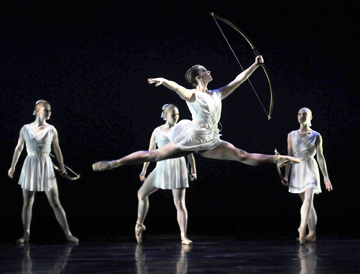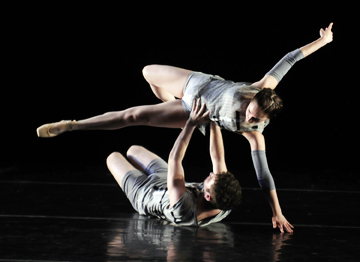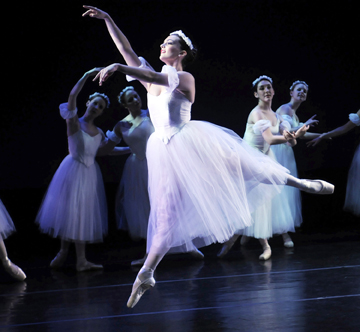Dance: A Hidden Gem: The Hartt School Dance Division
By Dawn Lille
ART TIMES Fall 2015
 The Hartt School students, photo by John Long |
Say Dance Division, Hartt School, University of Hartford and many will give a blank stare. This is to report that there is a great deal of excellent, joyful movement going on up in Connecticut, broadly educating students for the world of dance and beyond.
Originally founded in 1920 as a music school, which gained a distinguished reputation, in 1957 the Hartt School, by then a conservatory, was one of three institutions that joined to form the University of Hartford. The Dance Division, formerly associated with the Hartford Ballet/Dance Connecticut, was established in 1994 and was fully incorporated into the school in 2002. The Hartt is now a conservatory comprised of music, dance and theater. Dance has a rigorous community division as well.
Stephen Pier was recruited in fall 2009 to direct the program in dance. His aim is “to use the rich tradition of excellence in all the performing arts in conjunction with substantive innovation to prepare our students for meaningful careers.”
The major offers a BFA with a choice of emphasis on either performance or pedagogy. Both require extensive classes in dance technique (classical ballet, including pointe, modern and contemporary), music, dance history, improvisation, composition, kinesiology, repertory, technology, arts administration and pedagogy. Performance opportunities begin in the freshman year. The difference in the two tracks is that the teaching emphasis has more pedagogy and the performance more repertory and pas de deux classes. Both are required to take academic courses. Rhetoric and writing and math are required of all.
The results of this rigorous curriculum appear to accomplish Pier’s stated goal. These students are being groomed to lead dance into the future, but their education can do more than that. It can produce individuals able to apply their skills to a rapidly changing environment where Pier feels “they need both breadth and depth of knowledge to maintain professional agility.” He also realizes that they will be doing something besides performing during their working lives.
 The hartt School students Megan Dodd and ryan Bulson, photo by John Long |
Stephen Pier’s own history includes the role of performer with the Royal Danish Ballet, the Hamburg Ballet, the José Limón Company and as a guest artist with many others. His teaching and coaching career has included both ballet and modern dance and he has taught in many schools, including Juilliard. Pier has created over 40 works for the concert stage, opera, theater and film and has been involved in founding and directing workshops for choreographers.
He says that he inherited “an extraordinarily well designed program” that is unique in the quality of the faculty and the access the students have to them. He added Limón technique to the existing Graham and made adjustments resulting in greater flexibility in addressing individual student needs and inclinations. To him, each dance student is a different being in this most human of the arts, at a time when human interaction is a rare commodity.
Walking into a Saturday matinee performance in late April, I was introduced to the Dean of music, who was also joining the audience. The program was well rehearsed (down to the low keyed and professional bows) and danced by carefully trained young performers who appeared secure and, most importantly, joyful in their communication.
The program began with Valse Fantaisie, George Balanchine’s pas de deux to Glinka’s music. It is a rarity to see a Balanchine work on a college undergraduate offering. Staged by Hilda Morales, a faculty member and former American Ballet Theatre dancer, it was coached by Victoria Simon, a former New York City Ballet dancer. This was a neatly danced, honest, clearly defined version of a work by a 20th century genius. It was, moreover, an incomparable lesson in the history of choreography for the different casts that danced it.
Guernsey Field , a pastoral ballet for 8 women, was a lively hoedown in three parts entitled Daybreak, Sisters, Matriarchs and Women’s Work. The backdrop featured a series of old time farm photographs. The choreographer Katie Stevinson- Nollet, a faculty member, mined the idiosyncrasies of each character she created. The young women were juicy and sure- footed in their multi limbed antics and high energy, with a tinge of folk element, all to the music of Yo Yo Ma, Mark O’Connor and Edgar May.
Host , to Latin jazz music by Cal Tjader, was a world premiere created by Gemma Bond, an emerging ballet choreographer who is a member of American Ballet Theatre. In this work, which followed the four movements of the music, she had the females in the cast in pointe shoes. They looked strong, comfortable and contemporary.
 The Hartt School students, photo by John Long |
Doug Varone’s Four Chapters from a Broken Novel, to music by David Van Tieghem, showed four dances from a suite of twenty. Varone is an established NYC choreographer, with his own company and a range of interests that include opera, film, theater and fashion. He knows how to move bodies across, through and around the stage, while delving into their emotional selves, and the 11 dancers in the piece never stopped their search.
But to me the prize on the program was their ongoing reconstruction of Psalm, José Limón’s searing work in reaction to the holocaust and his reading of “The Last of The Just” by Andre Schwartz-Bart. The program note contained a poetry-like quote from the author, which lists the names of different concentration camps in between the words “and praised be the Lord.” There is also a footnote about the 36 just men in Jewish tradition, within whom rest all the sorrows of the world.
Limón, born in Mexico but a major figure in American dance history, conceived the dance as the history of one “just man.” The original score by Eugene Lester has been arranged and added to by Kathryn Swanson-Ellis .
This is a powerful, moving, beautifully constructed piece that used 14 dancers in two casts. With the typical Limón style of open torso, palms that speak, and every movement connected to the breath, the dance is spiritual in effect. Nina Watt, a faculty member who was a soloist with the Limón company, staged and directed this work, in which every movement was carefully calibrated and projected to its fullest impact.
The dancers exhibited strong technical training, but Pier insists that this is a tool that allows for expression, not an end in itself. He feels the Hartt Dance Division is different from other conservatories due to the positive culture and the support of the rest of the university. He says they have created an energizing educational model that exemplifies the thrill of continued learning and intellectual risk taking. .
The Hartt dancers will perform Psalm at the Joyce Theater in NYC when the Limón company appears there in October. What a wonderful opportunity!
dawnlille@aol.com
